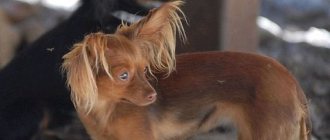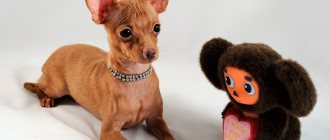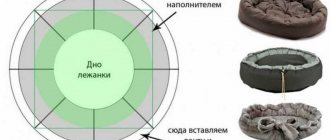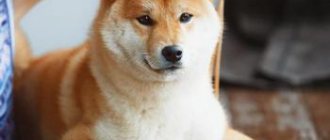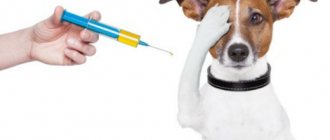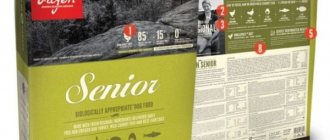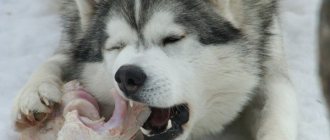Toy terriers are miniature dogs that look like puppies until they are old.
Like all purebred dogs, they have a standard weight and height.
The puppy's development must be monitored.
Since too small sizes can become a dangerous deviation - female toy terriers will not be able to bear offspring.
Difficulties in selecting drug dosages complicate treatment.
Find out about the norms of basic parameters in this article.
Adult pet weight
An adult dog weighs about 3 kg.
| Boys | Girls |
| 1.5-1.8 kg | 2-3 kg |
Sometimes there are mini toys weighing 0.9-1 kg. This weight is considered normal for a boy.
But if you are going to breed puppies, the Toya girl must weigh more than 1.8 kg for gestation and birth without complications.
More often 1-3 puppies are born . Their weight is 70-170 grams, which is a lot for such a small dog.
Expert opinion
Tolkachev Andrey Mikhailovich
veterinarian
The standard states that the weight should not exceed 3 kg. But such precision is needed for exhibitions. If your pet’s diet is balanced and there are regular walks, then a slight excess of 0.5 kg is not dangerous. Focus on appearance and the absence of symptoms of obesity: constipation, shortness of breath, sweating. Do not forget that there is a conditional division into super mini - 1.2 kg, mini - up to 1.5 kg and standard - 3 kg.
Puppy weight and height by month
The table is indicative. A discrepancy of ±300-400 g is possible. It is worth examining the dog if the weight differs from the table by 1 kg.
Puppies grow disproportionately: in one month they gain a lot, and in the next month the weight will not change . Focus on the condition of the toy. If he is active, playful and eats well, then everything is fine.
The conventional concept of norm also applies to growth.
Puppies are sold at approximately 3 months . At this moment their height is 15-20 centimeters.
The standard toy will grow even bigger by 6-9 months, but the mini toy will no longer be there.
Weight table:
| Age | Toy terrier weight at birth, g | ||||||||
| 70 | 80 | 90 | 100 | 120 | 130 | 145 | 160 | 170 | |
| 1 Week | 110 | 115 | 145 | 160 | 185 | 230 | 255 | 270 | 285 |
| 2 weeks | 145 | 160 | 185 | 200 | 255 | 315 | 355 | 390 | 415 |
| 3 weeks | 170 | 200 | 230 | 255 | 315 | 400 | 455 | 500 | 550 |
| 1 month | 200 | 230 | 270 | 320 | 370 | 485 | 540 | 595 | 650 |
| 2 months | 315 | 370 | 455 | 550 | 610 | 765 | 830 | 940 | 1050 |
| 3 months | 460 | 570 | 690 | 795 | 910 | 1135 | 1250 | 1390 | 1525 |
| 4 months | 600 | 750 | 880 | 1020 | 1165 | 1450 | 1620 | 1760 | 1900 |
| 5 months | 710 | 880 | 1025 | 1190 | 1365 | 1705 | 1875 | 2045 | 2200 |
| 6 months | 765 | 970 | 1150 | 1295 | 1510 | 1900 | 2100 | 2280 | 2500 |
| >1.5 years | 1000 | 1200 | 1400 | 1700 | 1900 | 2300 | 2500 | 2800 | 3000 |
Growth chart:
| Month | Height, cm |
| 1 | 6-10 |
| 2 | 10-14 |
| 3 | 14-20 |
| 4 | 18-24 |
| 5 | 20-28 |
| 6 | 20-28 |
| 6-9 | Formation is over |
Mini toy terrier
There is no separate standard for this breed . Mini toy terriers are usually classified as dogs whose sizes are smaller than standard ones.
The weight of an adult dog is less than 1.5 kg, the height at the withers is about 20 cm.
Mini Toy Terrier females are not allowed to give birth.
The mini toy is no different in character from the standard one. But it requires a more careful attitude. They break limbs much more often, and if they play carelessly, they can twist their jaw.
There are advertisements for the sale of super mini toy terriers . The weight of such dogs is up to 1.3 kg.
Diseases
Russian Toy Terriers can be considered a fairly healthy breed. When properly maintained, their lifespan is 12-15 years. The list of pathologies may seem impressive, but the diseases listed are typical for many mini dogs:
- dislocation of the knee joints;
- cataract;
- retinal atrophy;
- difficulty changing teeth;
- Legg-Calvé-Perthes disease;
- hydrocephalus;
- hypoglycemia;
- atlantoaxial instability;
- pancreatitis;
- conjunctivitis.
If we compare Toychiks with representatives of other dwarf breeds, we can note their resistance to genetic diseases. This may be due to the short selection period and favorable heredity.
When is a dog considered an adult?
Decorative breeds develop faster than others.
A dog is considered an adult when its period of physical development ceases.
This usually occurs at 6-9 months in a standard breed, 4-5 in a mini toy terrier..
Mental development ends at 4-5 months. Therefore, puppies are trained from a very early age.
Signs of an adult dog:
- eyes are clean, clear, without clouding;
- baby teeth were replaced by permanent ones;
- the dog’s body is toned, strong, proportional; height does not change, but weight may increase.
Description of the breed - history
English toy terriers began to be imported en masse to Russia in the mid-19th century. They gained unprecedented popularity among the aristocratic community and became the favorite breed of wealthy ladies. But then the revolution broke out, elite dogs began to wander in search of food and interbreed with mongrels. Only in the middle of the 20th century did breeders begin to restore ornamental breeds, which included toy terriers. Unfortunately, it was forbidden to export purebred dogs from England, so local scientists had to restore the population, using middle-class individuals as a basis. The result was a Russian version of the breed, far from the standard accepted abroad.
Until 1957, only the smooth-haired variety of terrier was known, until one day an ordinary pair of parents gave birth to a baby with long hair. The puppy was considered defective and sent to the kennel of the Moscow breeder Evgenia Fominichna Zharova. She appreciated the baby's potential and began selecting long-haired dogs. After a few years, the nursery had a stable population of fringed toy cats. The new variety of terriers had a number of serious differences from the original, so Zharova began working on its official recognition. In 1966, the longhaired subspecies received an approved standard and became a full-fledged breed.
After the fall of the Iron Curtain, the massive import of decorative dogs began, so toy terriers sharply lost ground. The breed had to be hastily restored; already in the nineties, the cost of babies increased rapidly. Toy terrier kennels were provided with orders for years to come.
Character
This breed owes its popularity not only to its appearance, but also to its friendly disposition. The toy is social and needs the approval of the owner. Despite its small size, the dog has a strong, fearless character. She will react to any suspicious sound and will rush to her owner’s defense without hesitation.
Toy terriers are suitable for people of all ages. They love children and pensioners equally. This breed has a sharp mind and easily remembers commands. Dogs try to be close to their owner and get very bored in his absence. Toys love to be the center of attention and often resort to cunning to earn it. They do not have a tendency to dominate, but they can be stubborn and capricious.
This breed needs training and education. If the owner does not set boundaries for what is permitted, the dog will quickly understand this. Therefore, it is recommended to correct the puppy’s behavior from the first days of life.
Some terriers are prone to aggression and do not like children. Professional training will help suppress such impulses. However, you should not have a toy terrier in families with small children: they can accidentally cause serious injury to the dog.
Parameters of an adult toy terrier
Boys and girls of toy terriers are almost no different from each other in appearance. In some breeds, boys are more impressive and larger, but toys do not have this feature.
The height of an adult animal is up to 28 cm, anything higher does not fit into the breed standard:
| Characteristics | Boys | Girls |
| Height | Up to 28 cm | 20-25 cm |
| Back length (from base of neck to beginning of tail) | 17-28 cm | |
| Chest size (behind front legs) | 25-40 cm | |
| Length of limbs (front) | 10-14 cm | |
According to the format, terriers are square.
For this format, the following characteristics apply::
- The oblique length of the body is equal to the height at the withers. Oblique length - from the extreme point of the chest to the sit bones. Height at the withers - from the ground to the withers.
- The back-lumbar-croup ratio is 2:1:1. If we conditionally divide the length of the dog (from the base of the neck to the beginning of the tail) in half, then the part at the neck is the back. Then comes the loin, followed by the croup.
- The height of the limbs is slightly more than half the height at the withers.
Common features
All the main types of toy terriers have one thing in common - they are small decorative “pocket” dogs that are exclusively a companion and friend to humans. Suitable for living in warmth and comfort, at home.
IMPORTANT!
During the cold season, all tois must be worn when going outside.
Common features are also:
- thin slender legs;
- compact body with a strong and straight back;
- active, playful character;
- obedient animal, trainable, undemanding;
- loyal to the owner, can warn of danger;
- friendly, but can show aggression when strangers appear and are treated rudely;
- fragile, like all dwarf dogs, needs constant attention.
Factors influencing performance
Growth and development depend on proper nutrition. The diet should contain minerals and vitamins, especially calcium, and healthy fats.
Decide on the type of food - natural or food. Mixed nutrition is undesirable.
It is better to feed your puppy on a schedule:
- 1.5 – 3 months: 4 times a day;
- 2 – 4 months: 3 times a day;
- 4 – 6 months: 2 times a day.
Serving size for 3-4 meals a day is about 30 g. You cannot overfeed, otherwise excess weight will form.
Calcium and phosphorus are essential for strong bones and teeth . A calcium deficiency is indicated by the toy's ears. If they first rose and then hung, the puppy needs vitamins. Multivitamins should be introduced into the diet gradually, monitoring the pet’s health.
The puppy is taken for vaccination. The first vaccination is given at approximately 6 weeks .
This prepares the body for the next dose. The next vaccination is given at 2.5 months, it will protect the body from diseases - distemper, hepatitis, etc. If the puppy suffers some kind of disease, the consequences are irreversible.
For example, after the plague, chronic diseases of internal organs, blindness, and paralysis occur.
Every 3 months, puppies are given anthelmintic drugs for prevention . If the puppy is lethargic, eats poorly and does not grow, then this is a sign of helminth infection.
Advantages
The advantages of the breed include:
- Kindness, lack of aggression, cuteness;
- Good mental abilities and learning ability;
- They behave wonderfully when traveling and can easily tolerate changes in environment;
- Devotion to the family, boundless love for the owner, affection;
- Good security qualities, despite its size;
- Compact, convenient, undemanding in content.
Flaws
There are no bad dogs, only ill-mannered ones. The character of a pet depends on several factors: heredity, manners instilled by the owner, psychological trauma. The chance of getting a healthy, balanced pet is much higher if the purchase is made at a nursery.
Most individuals have the following disadvantages:
- Mental instability, attacks of aggression and anger;
- Dislike for children, strangers, animals;
- Selfishness, jealous attitude towards personal objects and owners;
- Destructiveness (gnaw, scratch, drag everything they see)
- Fragility, pain, difficult childbirth.
Lack of weight: what to do?
Being underweight is no less dangerous than being overweight. Check the puppy weight chart by month.
If the ribs and spine of the toy terrier are noticeable even without palpation, then the dog is unhealthy thin.
If the puppy has stopped gaining weight, it is recommended:
- Give the puppy anti-helminth medications. When parasites are inside an animal, they prevent nutrients from being absorbed and suck them out themselves.
- Try giving your puppy more exercise. Play with him more often, take him for a walk.
- Increase the portion. Or increase the number of meals.
- Read the composition of the food. Meat ingredients should come first, not cereals. Buy food from the premium segment, marked “for puppies”.
- Contact your veterinarian. Weight loss is a symptom of diseases, such as hepatitis, cancer or inflammatory processes in organs.
Color
Previously, the only acceptable color was black and tan, and this continued until the mid-twentieth century. However, in the seventies, brown and red creatures began to be allowed into exhibitions, after which other original colors appeared. The skin of puppies is formed due to two pigments. This gives many different combinations.
The standard allows for the existence of all tan colors and any red shades. As a rule, tan marks are located above the eyes, on the chest, on the muzzle, and on the paws. They are also found under the ponytail, on the inside of the thighs. It is important that they are bright and clear.
The richer the better. Disadvantages include light marks on the chest and toes, large markings, and too dark markings. Dark, brown, blue color is also considered a disadvantage. White individuals, those who have such spots on the abdomen and on the head, are not allowed to compete. Large spots on the chest and neck are considered a disqualifying fault.
White
Unfortunately, such representatives of the breed are not allowed to compete. They do not participate in exhibitions and do not produce offspring that will someday receive an award.
However, they are very cute, their hair is soft and smooth to the touch. If you like such pets, you do not plan to win prizes, and perhaps you want to spay or neuter the dog, then why worry about whether the standard allows such colors? Feel free to have a baby like this!
You will have to take a little more care of this type of fur than standard fur, because it gets dirty quickly and needs to be cleaned more often. But this is not a big problem, because owners often prefer to walk their pets in clothes that prevent dirt from getting onto their fur coat.
To read: Unique Kurilian Bobtail cat: healer and friend
Ginger
Essentially, this is the same as fawn coloring. There are both light and bright variations of red skin.
Such dogs have an albinism gene, which makes the main pigments lighter.
This is one of the most common palettes; fiery terriers look very stylish, they are noticeable from afar, and stand out from others. It is desirable that the tone be very saturated; pale ones are also allowed, but are rated much lower.
Pearl
This is another name for cream color. More often, pearl babies appear in both light-colored parents, because the gene for this color is recessive.
Occasionally it happens that cream offspring are born from standard mothers and fathers who have hidden genes. These dogs have real aristocracy; they look attractive and elegant.
However, they need to be carefully looked after, because a light fur coat gets dirty faster and requires regular cleaning to maintain its aesthetics.
Sable
Sable dogs are those in which every hair is red on the roots and charcoal on the tips. As a rule, in childhood they are completely dark, but over time the hair at the roots lightens. If the baby was born already sable, you should be afraid that over the years he will become completely red. In some cases, the coal one remains only on the back or on the ears, and the fiery one dominates. This is a popular color, such terriers can be found everywhere, they correspond to the standard and are very popular.
Blue
Rare four-legged animals that look truly original. The same recessive gene is responsible for this fur coat color, which makes it less saturated.
It blurs the colors, as if brightening the skin. The gene initially went to a black kitten, it lightened its natural tone, and it was born gray-blue, and the brown one was born red-blue.
Such four-legged animals are called lilac ones. It seems that the fur of these animals is painted with watercolors, it looks so delicate and transparent. Let's say they have a tan. These are very expensive and valuable specimens; many people try to breed just such toys. They are slightly more expensive than standard ones.
Excess weight: causes and treatment
When a Toy Terrier becomes overweight, the stress on fragile bones increases . The risk of heart and liver diseases increases. The risk of diabetes increases.
Examine the dog yourself. While standing, feel the sides and back of the animal. If the ribs and spine are weak or cannot be felt at all, then the toy is overweight.
Constipation, excessive sweating and shortness of breath also indicate excess weight..
Causes of obesity:
- Poor nutrition. Overeating is unacceptable. Toys may not feel the measure. Limit access to food, introduce 2 meals a day.
- Sedentary lifestyle. Even if the dog goes to the tray or on a diaper, arrange walks in the air.
- Malfunctions of the body.
What to do:
- Consult your veterinarian. If a disease is detected, he will prescribe a course of treatment.
- Stick to your diet. Do not feed toy from the table, reduce the portion size. Change the food to something special for overweight dogs.
- Increase your physical activity. Play with your dog, buy toys. Go for walks regularly. If you have a lot of excess weight, start gradually. At first, just walk 30 minutes a day. When the dog becomes easier, introduce running and games.
NOTE!
The required caloric intake for a dog can be calculated using an online calculator.
You will need to enter the dog’s parameters, activity level and find out the number. The calorie content of one serving is usually indicated on the package; if eating natural foods, calculate the number of calories manually, for example, using a mobile application and scales.
Meeting height and weight standards is required to participate in shows . If you don’t plan to visit them, then don’t exhaust your dog in pursuit of the ideal. The most important thing for a toy terrier is the care of the owner.
Follow the basic rules - meals 2 times a day, no handouts from the table, physical activity and regular monitoring by a veterinarian.
Read more detailed information about caring for a toy terrier here.
Key points in training
Since this breed is decorative, their representatives are usually not trained. They have enough knowledge of basic commands, but the skill of executing them must be honed to perfection. Russian Toys are rarely obedient and flexible, but with proper upbringing they can be taught basic techniques:
- "Sit";
- "Voice";
- "Near";
- "Place".
Raising puppies begins from the first months of life. To prevent the dog from becoming the head of the family, you must not allow him to manipulate people.
You cannot feed from the master's table, teach him to sleep and jump on the master's furniture, or enter the house before other family members.
The owner needs to be persistent, strict, but not rude. They are vindictive and fragile; a slight blow can disrupt their nervous system.
Read about how to properly train a dog in the article: “Training a puppy: effective methods from dog handlers, learning commands at home.”
